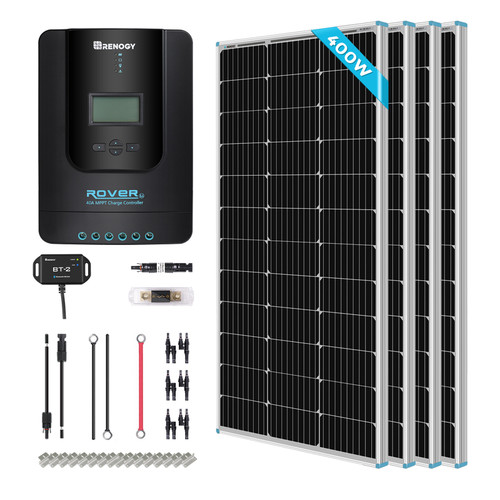Package Includes
- 2 Pieces of 100W Monocrystalline Solar Panel x 2
- 40A MPPT Solar Charge Controller x 1
- 12V 100Ah Deep Cycle AGM Battery x 2
- 2000W 12V Pure Sine Wave Inverter x 1
- 4 Set of Solar Panel Mounting Z Bracket x 4
- Solar Y Branch Connectors MMF+FFM Pair x 3
- 20FT 10AWG Solar Panel to Charge Controller Adaptor Kit x 1
- 8FT 8AWG Battery to Charge Controller Tray Cables x 1
- 16In 4AWG Copper Battery Interconnect Cable for 5/16 in Lugs x 2
- 1FT 8AWG ANL Fuse Cable with Double Ring Terminals for 3/8 in Lugs x 1
- 40A ANL Fuse Set w/ Fuse x 1
- 30A Solar Connector Waterproof In-Line Fuse Holder w/ Fuse x 1
- Battery Inverter Cables for 3/8 in Lugs x 2
- BT-2 Bluetooth Module x 1
- 500A Battery Monitor With Shunt x 1
- 2 Pieces of 100W Monocrystalline Solar Panel x 2
- 40A MPPT Solar Charge Controller x 1
- 12V 100Ah Smart Lithium Battery w/ Bluetooth & Self-heating Function x 2
- 2000W 12V Pure Sine Wave Inverter x 1
- 4 Set of Solar Panel Mounting Z Bracket x 4
- Solar Y Branch Connectors MMF+FFM Pair x 3
- 20FT 10AWG Solar Panel to Charge Controller Adaptor Kit x 1
- 8FT 8AWG Battery to Charge Controller Tray Cables x 1
- 16In 4AWG Copper Battery Interconnect Cable for 5/16 in Lugs x 2
- 1FT 8AWG ANL Fuse Cable with Double Ring Terminals for 3/8 in Lugs x 1
- 40A ANL Fuse Set w/ Fuse x 1
- 30A Solar Connector Waterproof In-Line Fuse Holder w/ Fuse x 1
- Battery Inverter Cables for 3/8 in Lugs x 2
- BT-2 Bluetooth Module x 1
Maximum Power: 100W
Maximum System Voltage: 600V DC (UL)
Open-Circuit Voltage (Voc): 24.3V
Optimum Operating Voltage (Vmp) 20.4V
Short-Circuit Current (Isc): 5.21A
Optimum Operating Current (Imp) 4.91A
Dimensions: 41.8 x 20.9 x1.4 in
Weight: 14.1lbs/6.4kg
Output Cables: 14 AWG (1.96 ft long)
opc:
Nominal System Voltage: 12V/24V Auto Recognition
Rated Charge Current: 40A
Max. PV Input Voltage: 100 VDC
Max. PV Input Power: 12V/520W, 24V/1040W
Max Battery Voltage: 32V
opc:
Continuous Output Power: 2000W
Peak Power Rating: 4000W
Output Voltage: 115V
Dimensions: 17.8 x 8.6 x 4 in
Weight: 11.7 lbs
opc:
Battery Type: AGM
Rated Capacity: 100Ah (10 Hour Rate to 10.5V)
Nominal Voltage: 12V
Cycle Use Voltage: 14.4V~14.8V
Dimensions: 13.1 x 6.9 x 8.6 in / 332 x 175 x 219 mm
Weight: 63.9 lbs / 29 kg
opc:
Battery Type: Lithium Iron Phosphate
Rated Capacity: 100Ah
Nominal Voltage: 10V to 14.8V
Dimensions: 10.6 x 7.6 x 8.1 in (268 x 193 x 205 mm)
Weight: 26.9 lbs. (12.2 kg)
opc:





































































































